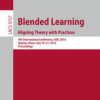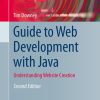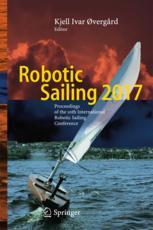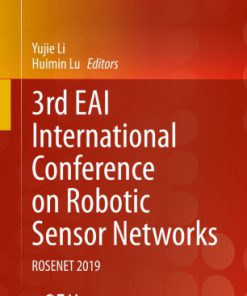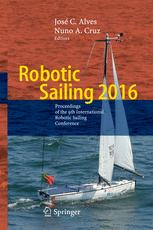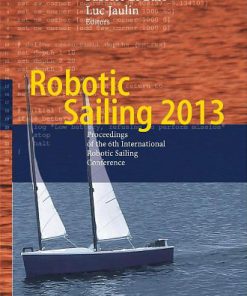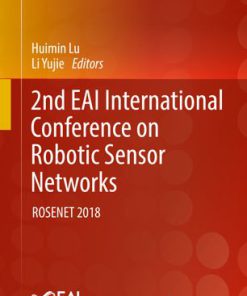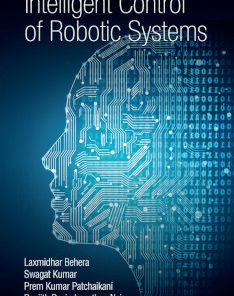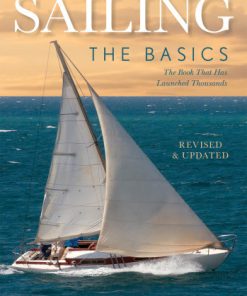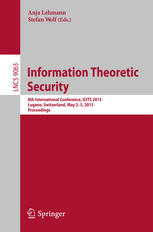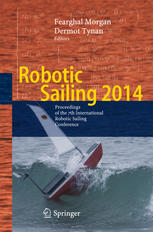Robotic Sailing 2015 Proceedings of the 8th International Robotic Sailing Conference 1st Edition by Anna Friebe, Florian Haug 3319233352 9783319233352
$50.00 Original price was: $50.00.$25.00Current price is: $25.00.
Robotic Sailing 2015: Proceedings of the 8th International Robotic Sailing Conference 1st Edition by Anna Friebe, Florian Haug – Ebook PDF Instant Download/DeliveryISBN: 3319233352, 9783319233352
Full download Robotic Sailing 2015: Proceedings of the 8th International Robotic Sailing Conference 1st Edition after payment.
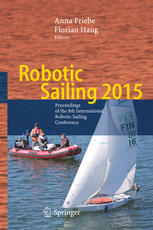
Product details:
ISBN-10 : 3319233352
ISBN-13 : 9783319233352
Author: Anna Friebe, Florian Haug
This book presents the cutting edge developments within a broad field related to robotic sailing. The contributions were presented during the 8th International Robotic Sailing Conference, which has taken place as a part of the 2015 World Robotic Sailing Championships in Mariehamn, Åland (Finland), August 31st – September 4th 2015. Since more than a decade, a series of competitions such as the World Robotic Sailing Championship have stimulated a variety of groups to work on research and development around autonomous sailing robots, which involves boat designers, naval architects, electrical engineers and computer scientists. While many of the challenges in building a truly autonomous sailboat are still unsolved, the books presents the state of the art of research and development within platform optimization, route and stability planning, collision avoidance, power management and boat control.
Robotic Sailing 2015: Proceedings of the 8th International Robotic Sailing Conference 1st Table of contents:
Part I Sailboat Platforms and Applications
1 A-TIRMA G2: An Oceanic Autonomous Sailboat
1 Introduction
2 Vessel’s Description
3 Summary
References
2 Integration of Wind Propulsion in an Electric ASV
1 Introduction
2 Background and Related Work
2.1 Using Wind for Propulsion
2.2 Wind Propelled ASVs
3 Design and Construction of the ASV Sail
3.1 Design Considerations
3.2 Sail Construction
3.3 Aerodynamic Characteristics of the Sail
4 Integration of Wind Propulsion
4.1 Physical Integration
4.2 Hybrid ASV Model
5 Strategies for Propulsion of a Hybrid ASV
5.1 Using the Wind as the Main Propeller
5.2 Coupled Wind and Electrical Thrust
6 Conclusions and Future Work
References
3 Mobile Autonomous Platforms for Passive-Acoustic Monitoring of High-frequency Cetaceans
Abstract
1 Introduction
2 Methods
3 Results
4 Discussion
Acknowledgments
References
4 Design and Development of a Self-Stabilizing, Autonomous Sailboat with Zero-Net Stored-Energy Use
1 Introduction
2 State of the Art
3 Boat Design
3.1 Mechanisms
3.2 Hull Constructions
3.3 Sail and Auto-Trim System Construction
3.4 Electrical Tail Option
3.5 Keel Construction
3.6 Control Surface Concepts
3.7 Control Hardware
3.8 Energy Harvesting
3.9 Energy Budget
3.10 Qualitative Wet Trials
4 Boat Dynamics
4.1 Simulations
4.2 Polar Plot
5 Navigation
5.1 Short Term Path Planning
5.2 Long Term Path Planning
6 Conclusions
References
5 Kite Sailing Platform Mathematical Model and Stabilization
Abstract
1 Introduction
2 Mast-Free Sailing Platform Model
2.1 General Kite Model Description
2.2 General Board Model Description
2.3 Mast-Free Platform Model Assumptions
2.4 Forces and Torques in Kite Axes System
2.5 Kite Motion Parameters Calculation Algorithm in Kite Coordinate System
2.6 Forces and Torques in Board Coordinate System
3 Mast-Free Sailing Platform Practical Stabilization Method Based on Kite Manual Control Experience
3.1 General Idea of Independent Parameters Control
3.2 Implementation of Independent Parameters Control in Automatic System
4 Conclusion
References
Part II Mission Planning, Localizationand Obstacle Avoidance
6 AIS-Enabled Collision Avoidance Strategies for Autonomous Sailboats
1 Introduction
2 Automating COLREGS for Robotic Surface Vessels
3 The Automatic Identification System—AIS
4 Strategies for Defensive Collision Avoidance
4.1 Why Defensive Collision Avoidance?
4.2 Assumptions and Definitions
4.3 Collision Avoidance Maneuvers
4.4 When to Initiate a Collision Avoidance Maneuver?
5 Conclusions
References
7 Consideration of State Representation for Semi-autonomous Reinforcement Learning of Sailing Within
Abstract
1 Introduction
2 Sailing Simulator
3 Semi-autonomous Reinforcement Learning
3.1 Reinforcement Learning
3.2 Semi-autonomous Reinforcement Learning
4 State Representation
5 Experiment and Results
6 Discussion
7 Conclusion
References
8 AEOLUS, the ETH Autonomous Model Sailboat
1 Introduction
2 Low-Level Control
3 Path Planning
4 Field Results
5 Conclusion
References
9 SWARMON—Real-Time Localization System
1 Introduction
2 Technical Choices
3 SWARMON Global System
3.1 The Ruby on Rails Web Framework
3.2 An Universal and Secured Front End
3.3 Hardware Tracker
3.4 Android Application
4 Sea Trials and Testing
5 Possibility of a Collision Avoidance System via HTTP Responses
6 Conclusion
7 Credits
References
Part III Controllers and Sensors
10 Autonomous Sailboat Track Following Control
1 Introduction
2 Sailboat Integration and Control Method
2.1 Sailboat Integration
2.2 Track Following Control Algorithm
2.3 Integration of Track Following Controller
3 Track Following Test Results
4 Conclusions
References
11 Modeling and Control for an Autonomous Sailboat: A Case Study
1 Introduction
2 Model for the Sailboat
3 Control Strategy and Simulations
4 State Estimation
5 Experimental Setup
6 Model and Trial Experiments
7 Conclusions
References
12 Quantitative Analysis of Various Sail Luffing Sensing Methods
1 History & Current Technology
2 Economic Comparison
3 Power and Interface Comparison
4 Data Comparison
4.1 Experimental Setup
4.2 Data Analysis
5 Use Recommendations
6 Conclusions and Future Work
People also search for Robotic Sailing 2015: Proceedings of the 8th International Robotic Sailing Conference 1st:
robotic sailboat
robotic sailing
robotic sailing marks
robotic sailing competition
a robotic fish
Tags: Robotic Sailing, Proceedings, International Robotic, Anna Friebe, Florian Haug
You may also like…
Computers - Computer Science
Computers - Computer Science
Mathematics - Optimal control
Intelligent Control of Robotic Systems 1st Edition Laxmidhar Behera
Hobbies & Games - Water Sports
Sailing the basics the book that has launched thousands Franzel
Computers - Computer Science
Computers - Computer Science


